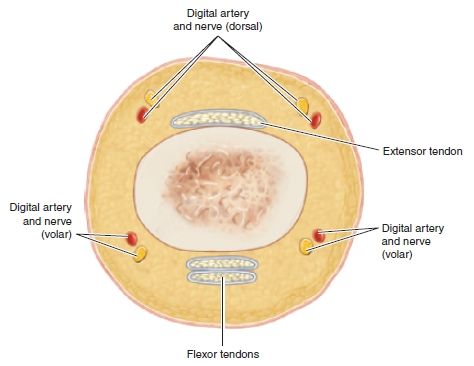Injection of local anesthetic around the digital nerves is a useful method to provide anesthesia of the fingers and toes so that surgical procedures may be conducted on those digits. The fingers and toes are innervated by two sets of nerves that course in the lateral aspect of each digit. There are a pair of dorsal and another pair of palmar/plantar nerves. Each nerve is associated with a corresponding artery. The objective of a digital nerve block is to bathe each of the four nerves with lidocaine to achieve total digital anesthesia while avoiding injury to the vascular structures. Traditionally, this procedure has been performed utilizing a two-injection dorsal technique. However, there is a large body of evidence that demonstrates superior efficacy and preference for a single-injection technique into the volar subcutaneous space at the proximal digit.1–4
As noted previously, there is now extensive evidence that withholding epinephrine in areas that contain end arterioles (including the digits) in patients with normal vascular flow is not necessary and is in fact a “medical myth.” Historical reviews,5 a prospective series in more than 3,000 patients6 and a retrospective review of 1,100 cases,7 have documented that it is safe to use lidocaine with epinephrine in the digits.
Lidocaine (1%) with epinephrine has a similar onset of action, but is significantly less painful and has a shorter duration of action than bupivacaine (0.5%).8–10 Therefore, the preferred method to perform a digital nerve block is a single injection of 1% lidocaine with epinephrine (1:100,000) into the volar subcutaneous space at the proximal digit to create a firm, turgid feel to the tissue.
Relevant Anatomy: (Fig. 3.5)

FIGURE 3.5 Digital anatomy.
PATIENT POSITION
- Recumbent on the examination/procedure table with the hand or foot extended to the clinician.
ANESTHESIA
- Topical vapocoolant spray is used to decrease the pain associated with injection.
EQUIPMENT
- 5-mL syringe
- 25-gauge, 1-in. needle
- 5 mL of 1% lidocaine with epinephrine
- One alcohol prep pad
- Topical vapocoolant stream spray
- Sterile gauze pads
TECHNIQUE
1. Locate the needle insertion site over the palmar/plantar crease at the junction of the digit and the palm or foot.4
2. Prep the insertion site with an alcohol pad.
3. Use topical vapocoolant stream spray to achieve transient local anesthesia.11
4. Using the no-touch technique, insert the 25-gauge 1-in. needle through the skin by a single, quick needle stick. Advance the needle in a few millimeters through the skin into the subcutaneous tissue (Fig. 3.6).
5. Inject about 2.5 mL of lidocaine with epinephrine as a bolus in the subcutaneous tissue.
6. Remove the needle and apply direct pressure with the gauze pad—spreading the local anesthetic up to the digital nerves.
7. Allow at least 5 to 10 min for the anesthesia to take effect.
8. Repeat the procedure if necessary.
9. Perform the digital procedure only after complete anesthesia is achieved.




